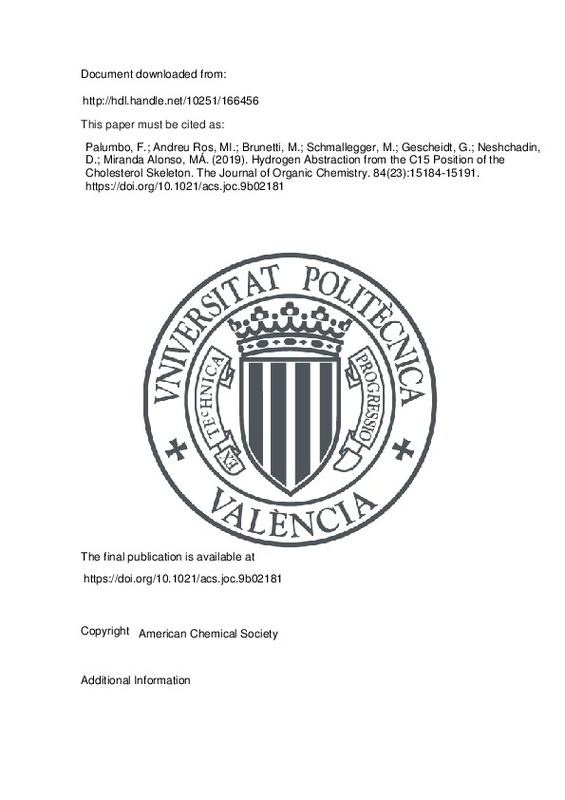Zerbinati, C., & Iuliano, L. (2017). Cholesterol and related sterols autoxidation. Free Radical Biology and Medicine, 111, 151-155. doi:10.1016/j.freeradbiomed.2017.04.013
Schroepfer, G. J. (2000). Oxysterols: Modulators of Cholesterol Metabolism and Other Processes. Physiological Reviews, 80(1), 361-554. doi:10.1152/physrev.2000.80.1.361
Girotti, A. W., & Korytowski, W. (2017). Cholesterol Hydroperoxide Generation, Translocation, and Reductive Turnover in Biological Systems. Cell Biochemistry and Biophysics, 75(3-4), 413-419. doi:10.1007/s12013-017-0799-0
[+]
Zerbinati, C., & Iuliano, L. (2017). Cholesterol and related sterols autoxidation. Free Radical Biology and Medicine, 111, 151-155. doi:10.1016/j.freeradbiomed.2017.04.013
Schroepfer, G. J. (2000). Oxysterols: Modulators of Cholesterol Metabolism and Other Processes. Physiological Reviews, 80(1), 361-554. doi:10.1152/physrev.2000.80.1.361
Girotti, A. W., & Korytowski, W. (2017). Cholesterol Hydroperoxide Generation, Translocation, and Reductive Turnover in Biological Systems. Cell Biochemistry and Biophysics, 75(3-4), 413-419. doi:10.1007/s12013-017-0799-0
Poli, G., Biasi, F., & Leonarduzzi, G. (2013). Oxysterols in the pathogenesis of major chronic diseases. Redox Biology, 1(1), 125-130. doi:10.1016/j.redox.2012.12.001
Buttari, B., Segoni, L., Profumo, E., D’Arcangelo, D., Rossi, S., Facchiano, F., … Riganò, R. (2013). 7-Oxo-cholesterol potentiates pro-inflammatory signaling in human M1 and M2 macrophages. Biochemical Pharmacology, 86(1), 130-137. doi:10.1016/j.bcp.2013.04.008
Scheinost, J., Wang, H., Boldt, G., Offer, J., & Wentworth, P. (2008). Cholesterolseco-Sterol-Induced Aggregation of Methylated Amyloid-β Peptidesâ Insights into Aldehyde-Initiated Fibrillization of Amyloid-β. Angewandte Chemie International Edition, 47(21), 3919-3922. doi:10.1002/anie.200705922
Shahidi, F., & Zhong, Y. (2010). Lipid oxidation and improving the oxidative stability. Chemical Society Reviews, 39(11), 4067. doi:10.1039/b922183m
Zielinski, Z. A. M., & Pratt, D. A. (2017). Lipid Peroxidation: Kinetics, Mechanisms, and Products. The Journal of Organic Chemistry, 82(6), 2817-2825. doi:10.1021/acs.joc.7b00152
Bignon, E., Marazzi, M., Besancenot, V., Gattuso, H., Drouot, G., Morell, C., … Monari, A. (2017). Ibuprofen and ketoprofen potentiate UVA-induced cell death by a photosensitization process. Scientific Reports, 7(1). doi:10.1038/s41598-017-09406-8
Bagheri, H., Lhiaubet, V., Montastruc, J. L., & Chouini-Lalanne, N. (2000). Photosensitivity to Ketoprofen. Drug Safety, 22(5), 339-349. doi:10.2165/00002018-200022050-00002
Breslow, R. (1980). Biomimetic control of chemical selectivity. Accounts of Chemical Research, 13(6), 170-177. doi:10.1021/ar50150a002
Breslow, R., Baldwin, S., Flechtner, T., Kalicky, P., Liu, S., & Washburn, W. (1973). Remote oxidation of steroids by photolysis of attached benzophenone groups. Journal of the American Chemical Society, 95(10), 3251-3262. doi:10.1021/ja00791a031
Zielinski, Z. A. M., & Pratt, D. A. (2016). Cholesterol Autoxidation Revisited: Debunking the Dogma Associated with the Most Vilified of Lipids. Journal of the American Chemical Society, 138(22), 6932-6935. doi:10.1021/jacs.6b03344
Garrec, J., Monari, A., Assfeld, X., Mir, L. M., & Tarek, M. (2014). Lipid Peroxidation in Membranes: The Peroxyl Radical Does Not «Float». The Journal of Physical Chemistry Letters, 5(10), 1653-1658. doi:10.1021/jz500502q
Farez, M. F., Quintana, F. J., Gandhi, R., Izquierdo, G., Lucas, M., & Weiner, H. L. (2009). Toll-like receptor 2 and poly(ADP-ribose) polymerase 1 promote central nervous system neuroinflammation in progressive EAE. Nature Immunology, 10(9), 958-964. doi:10.1038/ni.1775
Björkhem, I., Lövgren-Sandblom, A., Piehl, F., Khademi, M., Pettersson, H., Leoni, V., … Diczfalusy, U. (2011). High levels of 15-oxygenated steroids in circulation of patients with multiple sclerosis: fact or fiction? Journal of Lipid Research, 52(1), 170-174. doi:10.1194/jlr.d011072
Davies, H. M. L., & Morton, D. (2017). Collective Approach to Advancing C–H Functionalization. ACS Central Science, 3(9), 936-943. doi:10.1021/acscentsci.7b00329
Gutekunst, W. R., & Baran, P. S. (2014). Applications of C–H Functionalization Logic to Cyclobutane Synthesis. The Journal of Organic Chemistry, 79(6), 2430-2452. doi:10.1021/jo4027148
Neshchadin, D., Palumbo, F., Sinicropi, M. S., Andreu, I., Gescheidt, G., & Miranda, M. A. (2013). Topological control in radical reactions of cholesterol in model dyads. Chemical Science, 4(4), 1608. doi:10.1039/c3sc22109a
Andreu, I., Morera, I. M., Boscá, F., Sanchez, L., Camps, P., & Miranda, M. A. (2008). Cholesterol–diaryl ketone stereoisomeric dyads as models for «clean» type I and type II photooxygenation mechanisms. Organic & Biomolecular Chemistry, 6(5), 860. doi:10.1039/b718068c
Andreu, I., Palumbo, F., Tilocca, F., Morera, I. M., Boscá, F., & Miranda, M. A. (2011). Solvent Effects in Hydrogen Abstraction from Cholesterol by Benzophenone Triplet Excited State. Organic Letters, 13(15), 4096-4099. doi:10.1021/ol2016059
Boscá, F., Andreu, I., Morera, I. M., Samadi, A., & Miranda, M. A. (2003). Chiral discrimination in the intramolecular abstraction of allylic hydrogens by benzophenone triplets. Chem. Commun., (13), 1592-1593. doi:10.1039/b303263a
Kaptein, R., & Oosterhoff, L. J. (1969). Chemically induced dynamic nuclear polarization III (anomalous multiplets of radical coupling and disproportionation products). Chemical Physics Letters, 4(4), 214-216. doi:10.1016/0009-2614(69)80105-3
Closs, G. L. (1969). Mechanism explaining nuclear spin polarizations in radical combination reactions. Journal of the American Chemical Society, 91(16), 4552-4554. doi:10.1021/ja01044a043
Vollenweider, J.-K., Fischer, H., Hennig, J., & Leuschner, R. (1985). Time-resolved CIDNP in laser flash photolysis of aliphatic ketones. A quantitative analysis. Chemical Physics, 97(2-3), 217-234. doi:10.1016/0301-0104(85)87033-6
Neshchadin, D., Levinn, R., Gescheidt, G., & Batchelor, S. N. (2010). Probing the Antioxidant Activity of Polyphenols by CIDNP: From Model Compounds to Green Tea and Red Wine. Chemistry - A European Journal, 16(23), 7008-7016. doi:10.1002/chem.200903238
Kier, L. B. (1981). Quantitation of Solvent Polarity Based on Molecular Structure. Journal of Pharmaceutical Sciences, 70(8), 930-933. doi:10.1002/jps.2600700825
Poza, J., Rega, M., Paz, V., Alonso, B., Rodríguez, J., Salvador, N., … Jiménez, C. (2007). Synthesis and evaluation of new 6-hydroximinosteroid analogs as cytotoxic agents. Bioorganic & Medicinal Chemistry, 15(14), 4722-4740. doi:10.1016/j.bmc.2007.05.003
Poza, J. J., Jiménez, C., & Rodríguez, J. (2008). J-Based Analysis and DFT-NMR Assignments of Natural Complex Molecules: Application to 3β,7-Dihydroxy-5,6-epoxycholestanes. European Journal of Organic Chemistry, 2008(23), 3960-3969. doi:10.1002/ejoc.200800358
Frisch, M. J., Trucks, G. W., Schlegel, H. B., Scuseria, G. E., Robb, M. A., Cheeseman, J. R., Scalmani, G., Barone, V., Mennucci, B., Petersson, G. A. Gaussian 09, revision D.01; Gaussian, Inc.: Wallingford, CT, 2009.
Stephens, P. J., Devlin, F. J., Chabalowski, C. F., & Frisch, M. J. (1994). Ab Initio Calculation of Vibrational Absorption and Circular Dichroism Spectra Using Density Functional Force Fields. The Journal of Physical Chemistry, 98(45), 11623-11627. doi:10.1021/j100096a001
Becke, A. D. (1993). Density‐functional thermochemistry. III. The role of exact exchange. The Journal of Chemical Physics, 98(7), 5648-5652. doi:10.1063/1.464913
Schäfer, A., Horn, H., & Ahlrichs, R. (1992). Fully optimized contracted Gaussian basis sets for atoms Li to Kr. The Journal of Chemical Physics, 97(4), 2571-2577. doi:10.1063/1.463096
[-]







![[Cerrado]](/themes/UPV/images/candado.png)


